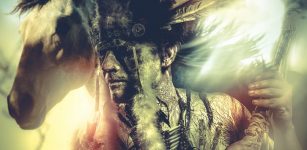Ehecatl: The Snake-Bird Deity And God Of Wind Feared And Respected By The Aztecs
A. Sutherland - AncientPages.com - Located in the Toluca Valley of highland central Mexico, Calixtlahuaca is one of the few Aztec-related urban sites, of which architecture and stone sculpture have survived until today.
Calixtlahuaca, a circular temple of Ehecatl, the Aztec god of wind. Image credit: INAH
Most of the settlement at Calixtlahuaca occupies the slopes of Cerro Tenismo, a small relict volcano. The Calixtlahuaca Aztec ruins near Toluca are scattered between the valley floor and the hill's summit.
The largest and best-known structure at Calixtlahuaca is a circular temple, where archaeologists discovered a life-sized stone sculpture of the Aztec god of wind, Ehecatl, which means 'Wind in Náhuatl.'
The Aztec codices confirm that Ehecatl was black with a conical head; he wore a red bird mask and shell jewelry, but his favorite piece of jewelry was a 'wind jewel' made of a conch shell.
Ehecatl was an important snake-bird deity (Quetzalcoatl) and god of air in the Aztecs' beliefs.
The Aztecs believed that the sound of the wind in the trees represented Ehecatl’s desire.
This deity symbolized fertility and human breath, which means this figure was closely associated with life force. The Aztecs believed that Ehecatl – by controlling all kinds of winds, even the strongest ones – could give life to Earth. Ehecatl's role was significant because he was credited with the creation of the present human race and the creation of the heavens.
One legend says that Ehecatl blew on the *sacrificial fire to stimulate the rising of the fifth sun and the fifth moon, the sun and moon of the present world, the fifth world. With such contributions, the Aztecs considered Ehecatl to be a creator god.
Left:Stone sculpture of Ehécatl, Wind God, National Museum of Anthropology, Mexico ; Right: Altar dedicated to the god Ehecatl, located in the middle of Metro Pino Suárez, Mexico City. Image credit: Thelmadatter - Public Domain
In Aztec myths and legends, Ehecatl plays an important role. One legend says that Ehecatl introduced sexual love to humankind; he once fell in love with Mayahuel, a maiden he brought from the Underworld. Their lovemaking caused a tree to grow.
The Aztecs believed that the sound of the wind in the trees represented Ehecatl's desire.
The Aztec codices confirm that Ehecatl was black with a conical head; he wore a red bird mask and shell jewelry, but his favorite piece of jewelry was a 'wind jewel' made of a conch shell.
Statue of Ehecatl-Quetzalcoatl, in the Brooklyn Museum (New York City). Life-Death Figure, 900-1250. (No restrictions)
The temples, which the Aztecs built to honor him, were circular-shaped with conical roofs to symbolize caves to the Underworld. According to one interpretation, a circle, which is endless and round, the temples' rounded corners may have represented the god Ehecatl's infinite powers.
One of the extraordinary finds made at the archaeological site of Calixtlahuaca during the XIX and XX centuries is a Romanesque figurine - a small terracotta head - unearthed in 1933 during the excavation of a burial offering in the Pre-Hispanic settlement of Tecaxic-Calixtlahuaca, located approximately forty miles NW of Mexico City.
It remains a mystery how it reached Caxtlahuaca, 40 km northeast of Mexico City. It is known the artifact is authentic and dates back to the 2nd century.
Written by – A. Sutherland AncientPages.com Senior Staff Writer
Updated on February 2, 2024
Copyright © AncientPages.com All rights reserved. This material may not be published, broadcast, rewritten or redistributed in whole or part without the express written permission of AncientPages.com
More From Ancient Pages
-
 Biblical Lydia ‘Woman Of Purple’ Who Run Her Own Business
Biblical Mysteries | Apr 9, 2019
Biblical Lydia ‘Woman Of Purple’ Who Run Her Own Business
Biblical Mysteries | Apr 9, 2019 -
 On This Day In History: Battle of Oosterweel Was Fought – On Mar 13, 1567
News | Mar 13, 2017
On This Day In History: Battle of Oosterweel Was Fought – On Mar 13, 1567
News | Mar 13, 2017 -
 Mysterious Headless Skeleton May Be Sir George Yeardley – The Man Who Shaped Early America
Archaeology | Aug 11, 2018
Mysterious Headless Skeleton May Be Sir George Yeardley – The Man Who Shaped Early America
Archaeology | Aug 11, 2018 -
 Stunning Facial Reconstruction Of ‘Siberian Tutankhamun’ And His ‘Queen’ Who Died 2,600 Years Ago
Archaeology | Jan 12, 2021
Stunning Facial Reconstruction Of ‘Siberian Tutankhamun’ And His ‘Queen’ Who Died 2,600 Years Ago
Archaeology | Jan 12, 2021 -
 On This Day In History: Great Sheffield Flood – Largest Man-Made Disaster Occurred In England – On Mar 11, 1864
News | Mar 11, 2017
On This Day In History: Great Sheffield Flood – Largest Man-Made Disaster Occurred In England – On Mar 11, 1864
News | Mar 11, 2017 -
 Mystery Of The Large Ancient Boulders In Ireland And Britain – Possible Connection To The City Of Troy?
Featured Stories | Oct 17, 2023
Mystery Of The Large Ancient Boulders In Ireland And Britain – Possible Connection To The City Of Troy?
Featured Stories | Oct 17, 2023 -
 Undiscovered Neanderthal Artifacts From The Ice Age Are Submerged Below The Waves Of The English Channel
Archaeology | Nov 23, 2022
Undiscovered Neanderthal Artifacts From The Ice Age Are Submerged Below The Waves Of The English Channel
Archaeology | Nov 23, 2022 -
 Lost Medieval Home Of The Lords Of The Isles – Reconstructed Virtually
Archaeology | May 29, 2019
Lost Medieval Home Of The Lords Of The Isles – Reconstructed Virtually
Archaeology | May 29, 2019 -
 Thousands Of Cannonballs Discovered In Southern India
Archaeology | Dec 23, 2015
Thousands Of Cannonballs Discovered In Southern India
Archaeology | Dec 23, 2015 -
 Evidence Humans Walked The Great Plains 18,000 Years Ago May Have Been Found – Archaeologists Say
Archaeology | Mar 14, 2022
Evidence Humans Walked The Great Plains 18,000 Years Ago May Have Been Found – Archaeologists Say
Archaeology | Mar 14, 2022 -
 Ur-Nammu – Popular And Accomplished Ruler Of Sumer
Civilizations | Oct 31, 2016
Ur-Nammu – Popular And Accomplished Ruler Of Sumer
Civilizations | Oct 31, 2016 -
 On This Day In History: Gutenberg Prints The First Bible – On Feb 23, 1455
News | Feb 23, 2017
On This Day In History: Gutenberg Prints The First Bible – On Feb 23, 1455
News | Feb 23, 2017 -
 On This Day In History: Mount Tambora Volcano Begins A Three-Month-Long Eruption – On Apr 10, 1815
News | Apr 10, 2017
On This Day In History: Mount Tambora Volcano Begins A Three-Month-Long Eruption – On Apr 10, 1815
News | Apr 10, 2017 -
 Grandfather Frost And Snow Maiden Bring Gifts On New Year’s Eve
Ancient Traditions And Customs | Dec 13, 2019
Grandfather Frost And Snow Maiden Bring Gifts On New Year’s Eve
Ancient Traditions And Customs | Dec 13, 2019 -
 When And Why Did Humans Start Using Tombstones?
Archaeology | Aug 29, 2022
When And Why Did Humans Start Using Tombstones?
Archaeology | Aug 29, 2022 -
 Oklahoma’s Ancient Mosaic Floor With Mysterious ‘Post Holes’ Could Re-Write History Of North America
Civilizations | Aug 10, 2018
Oklahoma’s Ancient Mosaic Floor With Mysterious ‘Post Holes’ Could Re-Write History Of North America
Civilizations | Aug 10, 2018 -
 Meteora – A Sanctuary Of Harmony And Quietness “Hanging” In The Sky
Civilizations | Aug 14, 2015
Meteora – A Sanctuary Of Harmony And Quietness “Hanging” In The Sky
Civilizations | Aug 14, 2015 -
 Merovingian Dynasty Of Long Haired Kings
Featured Stories | Jan 18, 2019
Merovingian Dynasty Of Long Haired Kings
Featured Stories | Jan 18, 2019 -
 Conwy Castle In Snowdonia: Outstanding Medieval Fortification In Europe
Featured Stories | Oct 16, 2018
Conwy Castle In Snowdonia: Outstanding Medieval Fortification In Europe
Featured Stories | Oct 16, 2018 -
 Killer-Of-Enemies – Mysterious Non-Human Teacher And Hero Of The Apache Indians
Featured Stories | Nov 16, 2020
Killer-Of-Enemies – Mysterious Non-Human Teacher And Hero Of The Apache Indians
Featured Stories | Nov 16, 2020




